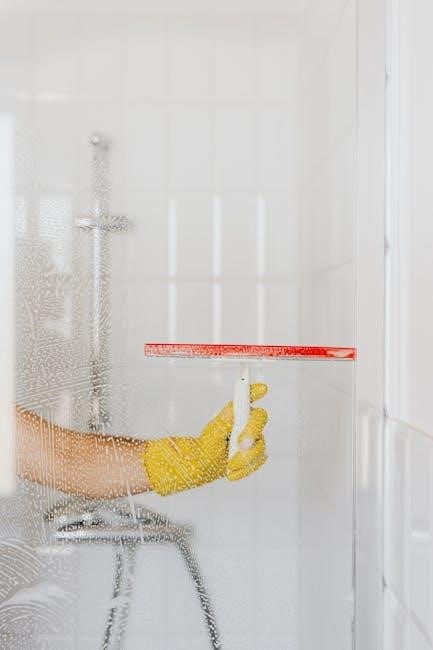Honeywell RTH230B Thermostat: An Overview
The Honeywell RTH230B is a programmable thermostat designed for user-friendly operation and energy savings. It features a digital display and intuitive controls. This model is suitable for various heating and cooling systems, offering a simple solution for home temperature management.

RTH230B Compatibility
The RTH230B thermostat is compatible with a range of heating and cooling systems. These include gas, fuel oil, and electric furnaces with 2 or 3 wires. It also supports central air conditioners and hot water systems, offering broad application across different residential setups.
Supported Heating and Cooling Systems
The Honeywell RTH230B thermostat offers versatile compatibility with a variety of home heating and cooling systems. It effectively controls gas, fuel oil, and electric furnaces, accommodating both 2-wire and 3-wire configurations. For cooling, it supports central air conditioning systems, also with 2-wire or 3-wire setups, providing efficient climate control during warmer months.
Furthermore, the RTH230B is suitable for managing hot water systems, including those with or without pumps, utilizing a 2-wire connection. It’s also compatible with millivolt systems, ensuring functionality in older homes with specific heating requirements. In central heating and cooling setups requiring more complex wiring, the thermostat supports 4-wire or 5-wire connections.
However, it’s important to note that the RTH230B is not designed for use with heat pump systems or other specialized HVAC configurations. Ensuring compatibility before installation is crucial for optimal performance and to prevent potential system malfunctions. Always consult the system’s documentation for compatibility.
Installation Guide
Installing the Honeywell RTH230B involves carefully removing your old thermostat. Then, you will need to correctly connect the appropriate wires. Following the provided instructions ensures proper setup and avoids potential issues with your heating and cooling systems.
Wire Identification and Connection
Before commencing the installation, the first crucial step is to carefully identify each wire connected to your old thermostat. Label each wire with the corresponding letter from the terminal. This is essential for ensuring accurate connections with the RTH230B. If necessary, use wire strippers to expose about ¼ inch of the wire end for a secure connection.
To prevent wires from falling back into the wall, wrap them around a pencil for temporary support. When connecting the wires to the RTH230B, ensure each wire is firmly attached to its designated terminal. Double-check the wiring diagram included in the manual to verify the correct configuration based on your specific heating and cooling system.
Incorrect wiring can lead to malfunction or damage, so precision is critical during this stage. The RTH230B supports various configurations, including 2-wire, 3-wire, 4-wire, and 5-wire systems, catering to different types of furnaces, air conditioners, and central heating/cooling setups.

Operating Instructions
Operating the Honeywell RTH230B is straightforward. Familiarize yourself with the buttons to adjust the temperature and set the desired mode. The thermostat offers both manual and permanent hold options for convenient control of your home’s climate.
Setting Temperature
To set the temperature on your Honeywell RTH230B thermostat, simply use the up and down buttons located on the thermostat’s face. Press the up button to increase the desired temperature, and the down button to decrease it. The current set temperature will be displayed on the screen.
Continue pressing the buttons until you reach your desired comfort level. The thermostat will then maintain that temperature until you change it again or until a programmed schedule takes effect, if you are using the programmable features.
The RTH230B also features an override function. This allows temporary adjustments to the temperature without affecting the programmed schedule. To use the override, simply adjust the temperature using the up or down buttons. The thermostat will hold the new temperature for a set period, after which it will return to the programmed schedule.
For optimal energy efficiency, consider setting different temperatures for different times of the day and night. This can be achieved by utilizing the programmable features of the RTH230B. Remember to consult the user manual for detailed instructions on programming your thermostat.
Understanding Control Modes (Manual/Permanent Hold)
The Honeywell RTH230B thermostat offers two primary control modes: Manual and Permanent Hold. Understanding these modes is crucial for effectively managing your home’s temperature.
Manual Mode: In Manual mode, the thermostat operates based solely on the temperature you set using the up and down buttons. It disregards any programmed schedules and maintains the set temperature continuously. This mode is ideal for situations where you want constant control and don’t need programmed settings.
Permanent Hold Mode: Permanent Hold mode functions similarly to Manual mode, but with a key difference. When you set a temperature in Permanent Hold, the thermostat maintains that temperature indefinitely until you manually change it again. It completely overrides any programmed schedules until you choose to exit Permanent Hold.
To activate either mode, consult your RTH230B user manual for specific button sequences or menu options. Typically, you’ll find an option to select Manual or Hold mode within the thermostat’s settings. Keep in mind that while these modes offer convenience, relying solely on them may not be the most energy-efficient approach compared to utilizing programmed schedules.

Programming Features
The Honeywell RTH230B thermostat provides basic programming features that allow users to customize temperature settings based on a schedule. This allows for energy savings and comfort by automatically adjusting temperatures throughout the day.
5-2 Day Programming: The RTH230B typically uses a 5-2 day programming structure. This means you can set one schedule for weekdays (Monday-Friday) and a separate schedule for the weekend (Saturday-Sunday). This caters to different routines people often have during the week versus on weekends.
Setting Time Periods: Within each day, you can usually define multiple time periods, such as “Wake,” “Leave,” “Return,” and “Sleep.” For each period, you set a desired temperature. This allows you to automatically lower the temperature while you’re away and raise it again before you return, or lower it at night while you sleep.
Easy Setup: While not as advanced as more modern smart thermostats, the RTH230B is designed for relatively easy programming. Clear instructions in the user manual guide you through setting the time, day, and temperature for each time period. By carefully programming your thermostat, you can optimize both comfort and energy efficiency.

Battery Replacement
The Honeywell RTH230B thermostat relies on batteries to maintain its settings and operate correctly. When the batteries are low, the display will usually show a low battery indicator. Replacing the batteries promptly ensures continuous operation and prevents loss of programmed settings.
Battery Type: The RTH230B typically uses two AA alkaline batteries. It’s essential to use the correct type of battery to avoid damage to the thermostat.
Replacement Procedure: To replace the batteries, first, locate the battery compartment, usually at the bottom of the thermostat. Gently open the compartment door. Remove the old batteries, noting the polarity (+ and -) indicated in the compartment. Insert the new AA batteries, ensuring they are aligned correctly with the polarity markings. Close the battery compartment door securely.
Important Considerations: It is recommended to replace the batteries annually, even if the low battery indicator is not displayed. This helps prevent battery leakage, which can damage the thermostat. When replacing batteries, it’s best to use high-quality alkaline batteries for longer life. After replacing the batteries, verify that the thermostat display is functioning correctly and that your programmed settings are still intact.
Troubleshooting
If your Honeywell RTH230B thermostat is not functioning as expected, several troubleshooting steps can help identify and resolve common issues. First, check the display. If it’s blank, ensure the batteries are correctly installed and have sufficient power. Replace the batteries with new ones if needed, making sure to align the polarity correctly.
If the thermostat is displaying an incorrect temperature, verify that it is not exposed to direct sunlight or other heat sources that could affect its readings. Resetting the thermostat to its factory defaults can also help resolve some issues. Refer to the user manual for instructions on how to perform a reset.
If the heating or cooling system is not responding to the thermostat’s settings, check the wiring connections to ensure they are secure and correctly matched. If you are uncomfortable working with electrical wiring, consult a qualified HVAC technician.
If the thermostat continues to malfunction after trying these steps, further assistance may be required. Contact Honeywell customer support or a professional HVAC service provider for expert diagnosis and repair.
